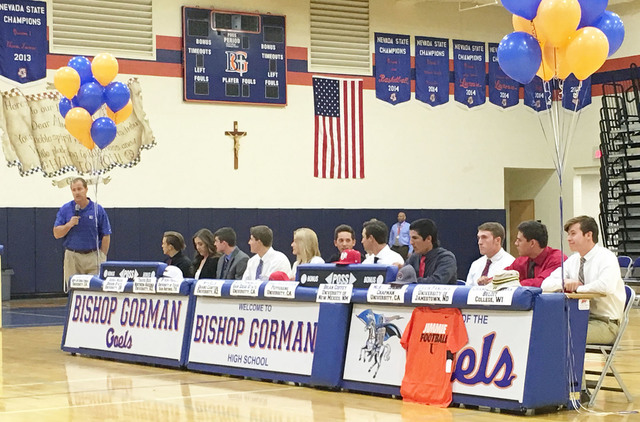Recruiting Game: Financial aid agreement gives athletes more flexibility than letter of intent

In some ways, it has become its own holiday.
National signing day, more celebrated in the life of a young athlete and his family than pretty much any holiday this side of Christmas, and publicized nearly as much by sports TV networks and websites.
But some of the elite high school athletes aren’t signing a national letter of intent. They’re opting instead to sign a financial aid agreement, a relatively new concept that drastically favors the athlete and makes the recruiting process more difficult for coaches and universities.
“It’s becoming more popular because it doesn’t box them in to any one place,” said UNLV associate athletic director for compliance Eric Toliver. “And with the coaches’ carousel, it at least leaves their option open so they don’t have to try to get out of an NLI if the coach leaves.”
What’s the difference between the two, and why wouldn’t an athlete want to sign a letter of intent? Simply, flexibility.
The letter of intent binds the school and the athlete to that agreement for one year, Toliver said. And for some sports, the time period during which a letter of intent can be signed is quite short.
The financial agreement binds the athlete to absolutely nothing and can be signed any time. The school, though, remains bound to uphold its end of the agreement if the athlete chooses to attend.
An athlete can only ever sign one national letter of intent. If he wanted to and had the offers, the athlete could sign an unlimited number of financial aid agreements and then still choose which school he wanted to attend.
“By not signing an national letter of intent, it lets them be a free agent with guaranteed money,” Toliver said.
If a star athlete is being courted by several Division I schools, he might choose to let the process play out longer than the window for the national letter of intent allows. With coaches often changing jobs, he might want to wait to see if the coach he wishes to play for is still at the school.
If he signs the national letter of intent, the athlete is bound to the school even if the coach leaves. He could appeal, but there’s no guarantee he’ll win. The financial agreement allows him to wait.
“If they’re not sure who is going to be the coach, that’s a valid reason,” Toliver said. “If they have offers of financial aid from this school, this school and this school, they don’t have to go to a school where they’re not sure of the coach.”
The financial agreement also allows the athlete the chance to see what else could open up.
If a standout basketball point guard has his heart set on going to Kentucky, but Kentucky didn’t initially offer a scholarship, he couldn’t sign a national letter of intent to go there. Now, if Kentucky’s star recruit blows out his knee in a pickup game or in his senior year of high school baseball, Kentucky could come calling. Meanwhile, the point guard already could have signed financial agreements with Duke, North Carolina, Oregon and Syracuse … and leave them all behind.
The signing of a financial aid agreement doesn’t end the recruiting process of an athlete. The signing of a national letter of intent does.
The school that thought it was getting the star athlete may end up empty-handed when he signs a financial aid agreement somewhere else.
“It makes it harder on the coaches because they have to keep recruiting that kid,” Toliver said. “Once they sign the NLI, they don’t have to recruit that kid anymore. They’re done. They’re ours.
“It’s not a stable thing. You don’t know if that kid is still coming until they officially get here.”
It can really wreck the plans of coaching staffs, who want to know as far in advance as possible whom they will have on campus next year and in the years to come.
Coaches are forced to have a Plan B if their top athlete doesn’t sign a national letter of intent and signs the financial letter.
“Plan B can’t stay on the back burner forever,” Toliver said. “They won’t.”
Coaches also risk a penalty if they sign too many kids, so they can’t exactly dangle an unlimited number of financial aid agreements out there for athletes. Oversigning, in essence offering more scholarships than the NCAA maximum, is a violation.
For now, it’s only the elite athletes, such as former UNLV basketball player and Bishop Gorman High School product Stephen Zimmerman, who can eschew the letter of intent and opt for the financial aid agreement. Zimmerman was highly sought after before selecting UNLV.
The average or slightly above average athlete who takes that risk and doesn’t sign a national letter of intent might find himself without any offers and nowhere to play.
“I don’t know that if it’s a good thing or a bad thing,” Toliver said. “It just has consequences and benefits.”